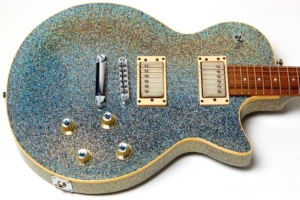 Here’s another rare Guild from the vault, this one being a 2002 Guild Bluesbird in limited edition Black Holoflake finish. When this guitar with its fairly divisive finish is listed for sale it is often accompanied with a fair bit of inaccurate information, all of which is easily believable due to a seeming lack of hard evidence to the contrary. Read along while I examine this rare beauty and attempt to set the record straight on this incredibly iridescent Guild Bluesbird Holoflake guitar.
Here’s another rare Guild from the vault, this one being a 2002 Guild Bluesbird in limited edition Black Holoflake finish. When this guitar with its fairly divisive finish is listed for sale it is often accompanied with a fair bit of inaccurate information, all of which is easily believable due to a seeming lack of hard evidence to the contrary. Read along while I examine this rare beauty and attempt to set the record straight on this incredibly iridescent Guild Bluesbird Holoflake guitar.
Fair warning: this is a long review, and while there’s no math, prepare to be dazzled with science while being dazzled by the guitar.
Introduction
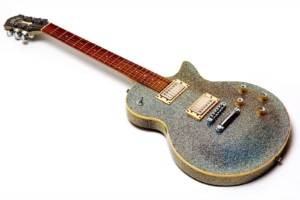 There seems to be a lot of misinformation about these guitars out there in Internet-land, and while I don’t want to fan the flames of discord, I’m going to write some things here that may upset those who disagree. I should add that I don’t think anyone who’s selling these guitars is trying to knowingly misrepresent them. The problem seems to be the result of a bit of an information vacuum, and when that happens people grasp at whatever “data” they can find and repeat it. There’s a lot of that on the Internet in general, so I can’t really blame anyone for believing what someone wrote on a forum 10 years ago if there’s never been any other information to refute it.
There seems to be a lot of misinformation about these guitars out there in Internet-land, and while I don’t want to fan the flames of discord, I’m going to write some things here that may upset those who disagree. I should add that I don’t think anyone who’s selling these guitars is trying to knowingly misrepresent them. The problem seems to be the result of a bit of an information vacuum, and when that happens people grasp at whatever “data” they can find and repeat it. There’s a lot of that on the Internet in general, so I can’t really blame anyone for believing what someone wrote on a forum 10 years ago if there’s never been any other information to refute it.
Let me say this from the start: If you have compelling evidence to the contrary of what you’re about to read, please do leave a comment or email me and I’ll update this article if the data proves your point. I’m always happy to be proven wrong provided you do so respectfully. Please also understand that what I’m including here is based on actual documentation and conversations with experts who know far more about Guild guitars than I do. With that having been written, let’s start with a zinger:
These are just regular Bluesbirds
OK, so that’s not 100% true because Bluesbirds have bound fretboards with block inlays, so these are certainly different in that regard, but aside from that the guitar is just a Bluesbird.
If you look at the NAMM flyer shown here. you’ll see the model number as 360-6400-850. According to the 2002 price list, The model number for the standard Bluesbird (literally the Bluesbird STD) is 360-6400. The Bluesbird AAA, which came with a AAA maple top, also has the same model number, but since the AAA came in different finishes than the STD, I imagine they thought that differentiating based on finish made sense since certain finishes were only available on the AAA models while others only showed up on the STD. The -850 suffix is the code for the finish on this guitar, but it does not necessarily mean Black Holoflake. More on that in a minute.
It’s a bit odd that the sheet from NAMM (shown here) lists the top as being a Carved Figured Maple Top and while I could lament them using a beautiful piece of flamed maple to spray all that sparkle over, I have to imagine that this is a typo or incorrectly copy/pasted text and that they used Bluesbird STD bodies. Bluesbirds are described in the 2002 price list as having a carved maple top with the figured carved maple top being reserved for the Bluesbird AAA. It is possible, I should point out, that there is a AAA top under all that sparkly goodness, but I’m not going to be the one to strip one of these rare guitars in order to find out. It also wouldn’t surprise me if Guild had a pile of AAA Bluesbirds with finish problems or blemishes in the wood that they chose to refinish since they’ve done exactly that in the past with other models. Thus, until definitive proof can be shown either way, I’d judge the inclusion of a Carved Figured Maple Top on these models as plausible.
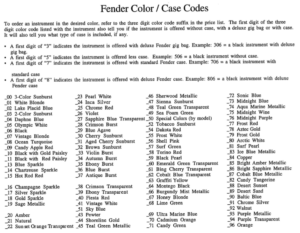 Back to the catalog number (360-6400-850), if 360-6400- means Bluesbird, then we’re left with -850 as the differentiator. Though the STD and AAA Bluesbirds both have the same model number, the STD Bluesbird had finishes like Black (-820), Red Transparent (-838), and Gold Metallic (-853) which didn’t really show off the top as much as the AAA colors Amber (-820), Cherry Sunburst (-830), and Tobacco Sunburst (-852).
Back to the catalog number (360-6400-850), if 360-6400- means Bluesbird, then we’re left with -850 as the differentiator. Though the STD and AAA Bluesbirds both have the same model number, the STD Bluesbird had finishes like Black (-820), Red Transparent (-838), and Gold Metallic (-853) which didn’t really show off the top as much as the AAA colors Amber (-820), Cherry Sunburst (-830), and Tobacco Sunburst (-852).
To further confuse matters, Guild changed all their color codes right around the time that this guitar was being sold. For example in 2001 Black had the code _06 and 806 meant that it came with a deluxe case (2001 price list) while a 2002 Bluesbird in black would have an -820 suffix, so it’s no wonder everyone is confused. This change appears to have been in order to align the color codes with Fender’s schemes. In the price guide _50 is for Special Colors (by model) and as stated above the 8__ means deluxe case, which is how we get the -850 suffix. It’s a Bluesbird (360-6400-850) in a deluxe case (360-6400-850) with a special color (360-6400-850). If you custom ordered a Bluesbird in 2002 with a Transparent Blue finish, I imagine that it would have the same model number.
On to myth #2:
These are not NAMM Guitars
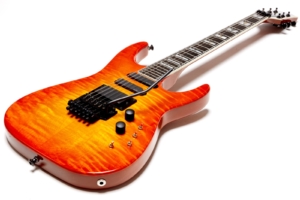 Another often-repeated claim is that the Holoflake Bluesbird was a NAMM guitar. It was not. But only 35 of them were supposedly made, so they’re a special model, right? Well, that comes down to a bit of semantics. While these guitars were a limited edition, and while that flyer does seem to have come from 2003 Winter NAMM, there is no evidence that they were made specifically for NAMM. I’ve heard from people who were there that there were a couple of these guitars on display, but that does not necessarily make them NAMM guitars. That may be a subtle distinction, so what I mean by NAMM Guitar is a guitar that was made specifically to be displayed at NAMM and not sold as a production guitar.
Another often-repeated claim is that the Holoflake Bluesbird was a NAMM guitar. It was not. But only 35 of them were supposedly made, so they’re a special model, right? Well, that comes down to a bit of semantics. While these guitars were a limited edition, and while that flyer does seem to have come from 2003 Winter NAMM, there is no evidence that they were made specifically for NAMM. I’ve heard from people who were there that there were a couple of these guitars on display, but that does not necessarily make them NAMM guitars. That may be a subtle distinction, so what I mean by NAMM Guitar is a guitar that was made specifically to be displayed at NAMM and not sold as a production guitar.
See the flamed orange super Strat pictured here? That is a Guild X4000 and is one of only two that I know of, both of which were made to show at NAMM (yes, a review is pending) and both of which have FFxxxxxx prototype serial numbers. That X4000 is a NAMM Guitar, and NAMM Guitars (at least from what I’ve seen from Guild) tend to be one or two of a kind which was not the case with these Holoflake Guilds. These are limited edition guitars that were shown at NAMM, not NAMM Guitars.
But, they’re Custom Shop guitars, right?
These are not Custom Shop Guitars
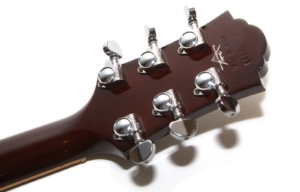 Many people also seem convinced that these are custom shop guitars, but they’re not. Remember, these were made when Fender not only owned Guild (which they had since 1995), but while they were building the guitars in the Corona, CA Fender plant after moving from Westerly, RI. Any Fender/Guild from this time period made in the custom shop has a custom shop logo on the back of the headstock like this one from my 2002 Custom Shop Bluesbird-90 (review also pending). There is no such stamping on this or any of the other Holoflake Bluesbirds I’ve seen for sale including any of these examples from Reverb: one, two, three, four, five. Note that the last one has P90s in it which is a rare configuration for what is already a pretty uncommon guitar.
Many people also seem convinced that these are custom shop guitars, but they’re not. Remember, these were made when Fender not only owned Guild (which they had since 1995), but while they were building the guitars in the Corona, CA Fender plant after moving from Westerly, RI. Any Fender/Guild from this time period made in the custom shop has a custom shop logo on the back of the headstock like this one from my 2002 Custom Shop Bluesbird-90 (review also pending). There is no such stamping on this or any of the other Holoflake Bluesbirds I’ve seen for sale including any of these examples from Reverb: one, two, three, four, five. Note that the last one has P90s in it which is a rare configuration for what is already a pretty uncommon guitar.
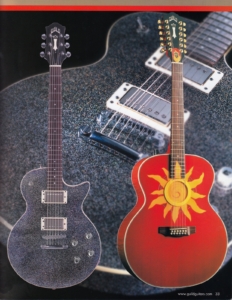 The only Guild Holoflake I’ve seen that does have the Fender Custom Shop logo on it is one of Steve Marker’s original one-pickup monsters as documented in this post on TheGearPage. If you look carefully at those pictures you can see the Custom Shop Logo on the back of the headstock, a feature missing on every other Guild Holoflake that I’ve seen.
The only Guild Holoflake I’ve seen that does have the Fender Custom Shop logo on it is one of Steve Marker’s original one-pickup monsters as documented in this post on TheGearPage. If you look carefully at those pictures you can see the Custom Shop Logo on the back of the headstock, a feature missing on every other Guild Holoflake that I’ve seen.
I think this confusion may be in part due to the fact that the Custom Shop pages in the 2003 catalog shows this model along with the very vague statement, Our popular electric Bluesbird model got a tailored Black Holoflake finish, inspired by the one-of-a-kind built for Steve Marker of Garbage (see page 42). To make matters worse, page 42 of that catalog has nothing to do with electric guitars, let alone this Bluesbird or even Steve Marker. I thought that maybe this was a holdover from the previous year’s catalog, but the 2002 Guild catalog only has 30 pages. It’s tempting to use guitar catalogs as a source of truth, but it’s amazing how many inaccuracies you find when you dig a bit.
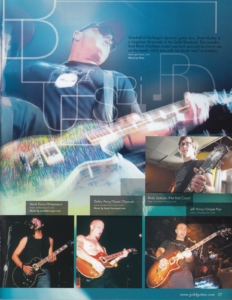 Back to the 2003 catalog, Steve Marker is on page 27 rocking his actual custom shop single pickup beauty so maybe that page was originally supposed to be on page 42 and the pages got shuffled around before going to print.
Back to the 2003 catalog, Steve Marker is on page 27 rocking his actual custom shop single pickup beauty so maybe that page was originally supposed to be on page 42 and the pages got shuffled around before going to print.
I’ve also seen many people repeat something to the effect that these guitars were made to celebrate Fender taking over Guild (which happened 7-8 years prior) or for Fender moving production to Corona (which is more likely), but then I’ve seen people claim their Bluesbird Holoflake was a 2001, 2002, or 2003, so take anything you read in a for sale ad regarding these guitars with a grain of salt. Still, the idea that they were made to celebrate something is plausible, so I can’t dismiss that one outright.
As for how many were made, I couldn’t say. I’ve read that only 17 of the planned 35 were made, but I don’t have access to records to prove or disprove any of that, so I’ll take it at face value that there were 35 made unless someone can prove otherwise. They do seem to be pretty uncommon which I would expect from a limited edition guitar.
Show me Some Videos, Dammit!
You can see Steve’s custom single-pickup Bluesbird Holoflake In this Youtube video where you can also see Duke Erikson’s (also from Garbage) nice ’90s Starfire III. As an aside they both make statements that Guild is no longer making electric guitars and the comments on that video are filled with, “Guild makes electric guitars!” but you have to remember that the video was posted in April of 2013 and Guild had just introduced the Newark St. line in January of that year so they probably just didn’t know about them yet, or like many of us, they didn’t take the import Newark St. guitars as seriously as the older US-made versions. I think they would have said something to that effect had they known, though.
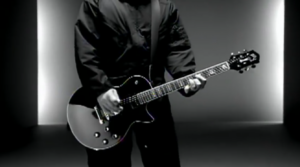 The best part of doing research for this guitar was rewatching all the Garbage music videos I could find, though sadly none of the Garbage music videos seem to show off this guitar. It absolutely should have been in the When I grow Up video but that was too early having been released in 1998 some four years before these guitars were made. If you’d like to see Steve Marker rockin’ a nice black Bluesbird, check out the video for I Think I’m Paranoid which is probably my favorite Garbage song, a fact which has absolutely nothing to do with Shirley Manson’s dress in that video. Did you know that she was a Terminator? That’s my kind of woman.
The best part of doing research for this guitar was rewatching all the Garbage music videos I could find, though sadly none of the Garbage music videos seem to show off this guitar. It absolutely should have been in the When I grow Up video but that was too early having been released in 1998 some four years before these guitars were made. If you’d like to see Steve Marker rockin’ a nice black Bluesbird, check out the video for I Think I’m Paranoid which is probably my favorite Garbage song, a fact which has absolutely nothing to do with Shirley Manson’s dress in that video. Did you know that she was a Terminator? That’s my kind of woman.
Finally, I did find another very cool video where the band is rehearsing I Think I’m Paranoid, this time with Steve Marker playing his custom shop Holoflake Bluesbird.
Whew! With all that out of the way, let’s take a look at this guitar.
The case
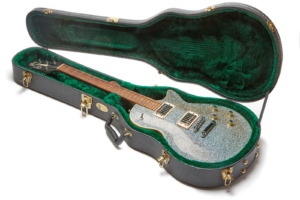 The proper case for this guitar is a very nice TKL case with a Guild emblem on the outside and green fur lining on the inside. This case had a part number of 350-1075-200 according to the NAMM flyer, and while the guitar will likely fit in other cases, this is the correct one, so if you come across one of these guitar without its original case make sure the price has been properly adjusted. This case model was shared with the Bluesbird and the S4CE acoustic guitar since they have the same shape, along with the S100 and Blues-90 according to this catalog page from 2003.
The proper case for this guitar is a very nice TKL case with a Guild emblem on the outside and green fur lining on the inside. This case had a part number of 350-1075-200 according to the NAMM flyer, and while the guitar will likely fit in other cases, this is the correct one, so if you come across one of these guitar without its original case make sure the price has been properly adjusted. This case model was shared with the Bluesbird and the S4CE acoustic guitar since they have the same shape, along with the S100 and Blues-90 according to this catalog page from 2003.
Finish
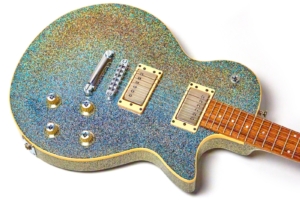 The main thing that distinguishes this guitar from other Guild Bluesbirds is quite obviously the finish, and I’m going to go into some agonizing detail about that. But first, what is the actual name? Holoflake? Holo-Flake? Is it Upper-case? Lower-case? Hyphenated? I’ve seen almost every variation.
The main thing that distinguishes this guitar from other Guild Bluesbirds is quite obviously the finish, and I’m going to go into some agonizing detail about that. But first, what is the actual name? Holoflake? Holo-Flake? Is it Upper-case? Lower-case? Hyphenated? I’ve seen almost every variation.
The flyer from NAMM says Holo-Flake, but every word is capitalized on that sheet which is a bit odd. The 2003 catalog says Holoflake. The price guides… Well they don’t say anything about it for reasons explained in the introduction. After far too much research looking for patents and trademarks, I believe that Holoflake is a product of Spectratek who offers Geometric Pigment and Holoflake Holographic Glitter to the cosmetics, paint and plastic packaging industries. Although I couldn’t find any current trademark (I did find this cancelled one) I’ve decided to standardize on Holoflake.
Every surface of the guitar is covered in Holoflake and finished in gloss polyurethane with the exception of the binding, the fretboard, and the headstock veneer. Even the back of the neck and the back of the headstock is Holoflake which makes it a bit of a challenge to read the serial number, but I’ll get to that later on.
The finish has two major effects that pop out when you see it. First, it quite obviously sparkles. In photography we call bright spots of light on shiny objects specular highlights, and this guitar makes a lot of ’em. Second, it refracts light in each one of those specular highlights into a rainbow where the primary color seen varies based on your position in relation to the individual flake along with the angle of incidence of the light source.
Um… what?
It makes rainbow sparkles. Because it’s Holoflake. Duh.
What is Holoflake?
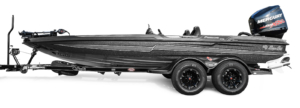 I’ve seen this model referred to as the bass boat guitar which is a comical reference to the fact that they’re sparkly like so many bass boats, and I’ve heard the sparkle on bass boats referred to as man glitter which made me laugh, but the pedantic word-nerd in me needs to point out that the finish on this Guild is not glitter, and it’s not the same finish that’s on bass boats, so please allow me a brief digression into the differences between the metal flake used on bass boats and the Holoflake finish used on this guitar.
I’ve seen this model referred to as the bass boat guitar which is a comical reference to the fact that they’re sparkly like so many bass boats, and I’ve heard the sparkle on bass boats referred to as man glitter which made me laugh, but the pedantic word-nerd in me needs to point out that the finish on this Guild is not glitter, and it’s not the same finish that’s on bass boats, so please allow me a brief digression into the differences between the metal flake used on bass boats and the Holoflake finish used on this guitar.
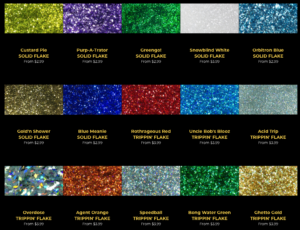 The finish on this guitar is called Black Holoflake, which is different than the more commonly seen metal-flake finishes. How? From what I’ve read (and I am no expert here) the means to accomplish the metalflake look is by spraying any of a number of metal flakes over a base coat, then finishing with clear-coat. Metal flakes come in a wide variety of colors often sporting some pretty outrageous names like Bong Water Green, Agent Orange, Purp-A-Trator, and my personal favorite for a guitar, Uncle Bob’s Blooz, all examples from the RothMetalFlake.com.
The finish on this guitar is called Black Holoflake, which is different than the more commonly seen metal-flake finishes. How? From what I’ve read (and I am no expert here) the means to accomplish the metalflake look is by spraying any of a number of metal flakes over a base coat, then finishing with clear-coat. Metal flakes come in a wide variety of colors often sporting some pretty outrageous names like Bong Water Green, Agent Orange, Purp-A-Trator, and my personal favorite for a guitar, Uncle Bob’s Blooz, all examples from the RothMetalFlake.com.
While metal flake is very cool, that’s not what’s on this guitar; this guitar’s finish is called Black Holoflake. While the Holoflake finish is made with the same technique, instead of using metal flakes, the flakes are of holographic film. What is holographic film you ask? Buckle up and learn why my reviews take so damn long.
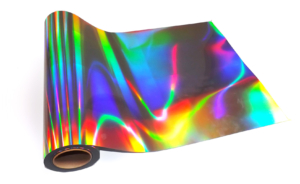 According to NobelusUniversity.com, Holographic film is a very thin, flexible plastic film [Polyester (PET), Oriented Polypropylene (OPP) and Nylon (Bonyl)] which has been micro-embossed with patterns or even images. Patterns (such as checker plate or diamonds) or an image (such as a tiger) are created by way of an embossing process which can provide a remarkable 3-D effect and/or spectral (rainbow) coloring. The embossing process is akin to cutting tiny grooves into the films surface at various angles and in different shapes. These micro-embossed grooves cause the “diffraction” of normal white light into stunning spectral color. The page goes on to say, Holographic polyester films can also be chopped into glitter or powder and then applied to textile products or mixed into other materials to provide a highly unique holographic effect.
According to NobelusUniversity.com, Holographic film is a very thin, flexible plastic film [Polyester (PET), Oriented Polypropylene (OPP) and Nylon (Bonyl)] which has been micro-embossed with patterns or even images. Patterns (such as checker plate or diamonds) or an image (such as a tiger) are created by way of an embossing process which can provide a remarkable 3-D effect and/or spectral (rainbow) coloring. The embossing process is akin to cutting tiny grooves into the films surface at various angles and in different shapes. These micro-embossed grooves cause the “diffraction” of normal white light into stunning spectral color. The page goes on to say, Holographic polyester films can also be chopped into glitter or powder and then applied to textile products or mixed into other materials to provide a highly unique holographic effect.
In short, metal-flake will reflect light from each flake (the ones in the correct orientation, anyway) and will give a sparkle to whatever color it’s based on. Put another way, think about a roll of aluminum foil (aluminium for you Brits). The roll of foil is silver, and thus reflects light like a mirror (if polished smooth) so you don’t see rainbows in the reflections, but rather full-spectrum white light instead. If you were to make red (or green or blue, etc.) foil you’d see red (or green, or blue, etc.) reflections as you might imagine.
By contrast, a roll of holographic foil like this one from Indiamart.com reflects and refracts the light (like a prism) instead of just reflecting it (like a mirror) which is what gives it the rainbow sheen seen in the pics. Where it gets more complicated is the fact that this rainbow effect changes based on your orientation to the material and to the light source.
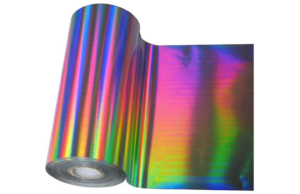 The key difference is that metal-flake uses flakes that look like aluminum foil while Holoflake uses flakes of holographic foil. Because of this difference, Holoflake will give a rainbow cast from every flake regardless of orientation (within reason) since differently oriented flakes will return a different wavelength of light. This means that the “sparkles” that would be white light from metal-flakes will actually be a very cool rainbow pattern from Holoflake. Again, this effect varies based on the position of the viewer and the source light, which brings me to my next point.
The key difference is that metal-flake uses flakes that look like aluminum foil while Holoflake uses flakes of holographic foil. Because of this difference, Holoflake will give a rainbow cast from every flake regardless of orientation (within reason) since differently oriented flakes will return a different wavelength of light. This means that the “sparkles” that would be white light from metal-flakes will actually be a very cool rainbow pattern from Holoflake. Again, this effect varies based on the position of the viewer and the source light, which brings me to my next point.
Photographing A Holoflake Guitar
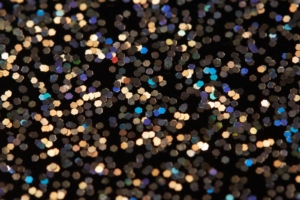 This is the most confounding thing I’ve ever tried to photograph. The guitar is actually finished in black. That’s right – this is a black guitar! Here’s a closeup of the finish to prove my point if you don’t believe me based on the name of the finish which is, after all, Black Holoflake. The Holoflakes, which at a distance appear to completely cover the guitar, are actually only covering about 50% or so of the finished surface. Those flakes are very reflective (and refractive!), though, and so the camera wants desperately to expose the light coming from those little hexagonal flakes.
This is the most confounding thing I’ve ever tried to photograph. The guitar is actually finished in black. That’s right – this is a black guitar! Here’s a closeup of the finish to prove my point if you don’t believe me based on the name of the finish which is, after all, Black Holoflake. The Holoflakes, which at a distance appear to completely cover the guitar, are actually only covering about 50% or so of the finished surface. Those flakes are very reflective (and refractive!), though, and so the camera wants desperately to expose the light coming from those little hexagonal flakes.
Of course as I wrote earlier they’re not just mirrors because they refract white light into its composite colors. Part of the problem is that the camera then tries to focus those light points and in doing so reassembles the colors into white pinpoints. Why? Because the guitar is creating something that the lens designers consider to be chromatic aberration.
Here comes some science! I swear we’re almost done.
A Brief Physics Tangent
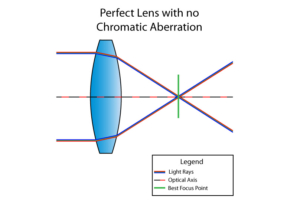 A perfect lens (which doesn’t exist) focuses all the colors of “white” light to the same point. Lenses bend light which is how they magnify things, but because different thicknesses of glass reflect different wavelengths of light differently, they focus each of those wavelengths (colors, essentially) into a different point. This is a problem which generally leads inexpensive lenses to suffer something commonly called purple fringing which is really just another term for chromatic aberration. If you’d like to learn more about chromatic aberration check out this link which is where I borrowed these images from. Remember, that first image is of a theoretically perfect lens. How does a real lens focus light?
A perfect lens (which doesn’t exist) focuses all the colors of “white” light to the same point. Lenses bend light which is how they magnify things, but because different thicknesses of glass reflect different wavelengths of light differently, they focus each of those wavelengths (colors, essentially) into a different point. This is a problem which generally leads inexpensive lenses to suffer something commonly called purple fringing which is really just another term for chromatic aberration. If you’d like to learn more about chromatic aberration check out this link which is where I borrowed these images from. Remember, that first image is of a theoretically perfect lens. How does a real lens focus light?
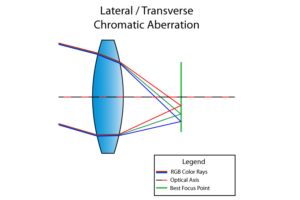 As mentioned, a simple lens will split white light up into different colors, each of which focusing on a different point. In its simplest form this is called axial chromatic aberration, but that’s not what’s the issue here with photographing this guitar. With the guitar, we have multiple points of light which have been refracted into colors, and those multiple points are across a fairly large area which you can imagine as this image times thousands of specs of colored light.
As mentioned, a simple lens will split white light up into different colors, each of which focusing on a different point. In its simplest form this is called axial chromatic aberration, but that’s not what’s the issue here with photographing this guitar. With the guitar, we have multiple points of light which have been refracted into colors, and those multiple points are across a fairly large area which you can imagine as this image times thousands of specs of colored light.
Now, where things get weird is that good camera lenses are designed to prevent chromatic aberration by using expensive lens elements to focus all of the different colors unto the same focal plane. Where things get weirder is the fact that we generally don’t have perfect vision, and so when we look at the guitar we see sparkling slightly out of focus dazzling colors, but the camera tries its damndest to get rid of all those colors (because they’re aberrations) and tries to focus as perfectly as possible.
Why the lesson? (I swear, we’re almost done!)
A Quick Photography Disclaimer
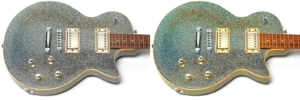 Normally when I photograph a guitar I take great care to make it look great while also trying to make the guitar look accurate. For reasons that I’ve tried to explain in great gory detail above, that was almost impossible for this guitar. The two pictures shown here are actually the same original raw photograph processed different ways. The one on the left is what the camera generally produced if left to its own devices while the one on the right is much closer to what you see when looking at the guitar in person. In order to accentuate the rainbow colors in the finish I had to boost the saturation a great deal which makes the pickup rings and fretboard look a bit wrong, though most people wouldn’t notice, having been entranced by the finish.
Normally when I photograph a guitar I take great care to make it look great while also trying to make the guitar look accurate. For reasons that I’ve tried to explain in great gory detail above, that was almost impossible for this guitar. The two pictures shown here are actually the same original raw photograph processed different ways. The one on the left is what the camera generally produced if left to its own devices while the one on the right is much closer to what you see when looking at the guitar in person. In order to accentuate the rainbow colors in the finish I had to boost the saturation a great deal which makes the pickup rings and fretboard look a bit wrong, though most people wouldn’t notice, having been entranced by the finish.
 This image from the top of the page is actually a sort of a manual High Dynamic Range (HDR) image that I created by combining both images together in order to try and make the guitar more natural looking while also accentuating the incredible finish.
This image from the top of the page is actually a sort of a manual High Dynamic Range (HDR) image that I created by combining both images together in order to try and make the guitar more natural looking while also accentuating the incredible finish.
Normally the part of my write-ups that takes the most time is the writing and editing, but for this article the task that consumed the most time by far was trying to get the guitar to look even a third as amazing as it does in real life. When you see people selling these guitars and they say that the pictures don’t do it justice, they are not kidding. In real life, the guitar’s finish is vibrant and very colorful with the rainbow effect changing with every movement of the guitar. Couple that with some bright stage lights and it would be crazy cool on stage.
Back to the guitar
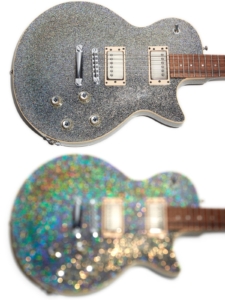 These two images are the same guitar taken under the same light with the white background forced to pure white to match all the other images on my page. The top image is a result of the camera focusing perfectly and the lens (a Canon 24-105mm f/4L) doing its best to remove all chromatic aberrations in order to make the image “better”. I also shot the top image like I normally do with a very small aperture in order to have a nice depth of field so that the entire guitar is in focus. The problem is that the guitar just looks silver. It is not.
These two images are the same guitar taken under the same light with the white background forced to pure white to match all the other images on my page. The top image is a result of the camera focusing perfectly and the lens (a Canon 24-105mm f/4L) doing its best to remove all chromatic aberrations in order to make the image “better”. I also shot the top image like I normally do with a very small aperture in order to have a nice depth of field so that the entire guitar is in focus. The problem is that the guitar just looks silver. It is not.
On the bottom image I turned off autofocus and manually turned the focus ring so that the guitar was blurry. I’m not joking when I say that those colors are what you see when you have the guitar in front of you, and this is why every ad for these guitars you’ll see will have a disclaimer stating that the photos don’t do it justice, but we’re getting there. The guitar is absolutely dazzling in person.
Oh, and remember that catalog page with Steve Marker from the introduction? Now you know why it’s out of focus.
I tried for days to get pics of this guitar that represented how it looks in person, and I did manage some good shots in the end, but in order to get the pics to show those dazzling colors the guitar must be partially out of focus (shallow depth of field) which is not what review photos should be. This frustrated me like you wouldn’t believe.
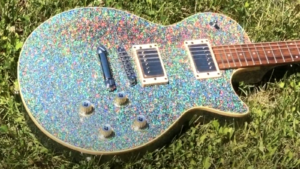 Then I decided to take it outside, but before we go for the big reveal, see this picture? Pretty, right? It still does not do the guitar justice!
Then I decided to take it outside, but before we go for the big reveal, see this picture? Pretty, right? It still does not do the guitar justice!
The only way I’ve been able to convey the guitar’s hypnotic brilliance is through video, and high-definition video at that. The first video, which you can see by clicking on the photo of guitar face up in the grass (or by using this link) is of the guitar in the sun. Lest you think I’ve resorted to some digital trickery, I assure you that I have not. The guitar actually looks like this in person, and you’d be tempted to check if it’s been covered by Swavroski crystals when you first gaze upon its magnificence.
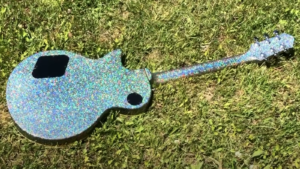 What’s crazy is the fact that the back is even more impressive owing to the fact that the entire surface including the neck and headstock are covered in Holoflake. This video, which you can see by clicking the picture of the guitar lying face down in the grass (or with this link) will surely make you understand why people say that photos don’t do the finish justice. It is absolutely breathtaking in person.
What’s crazy is the fact that the back is even more impressive owing to the fact that the entire surface including the neck and headstock are covered in Holoflake. This video, which you can see by clicking the picture of the guitar lying face down in the grass (or with this link) will surely make you understand why people say that photos don’t do the finish justice. It is absolutely breathtaking in person.
Fretboard and Neck
While Steve Marker’s original single pickup Holoflake Bluesbird has a bound neck with block inlays, these guitars do not, and that’s my first complaint with the design of this guitar. Since most other Bluesbirds (except for the Blues-90) have bound fretboards and blocks, I think this one looks odd without them. It doesn’t affect playability at all since the fretboard edge is wonderfully smooth and the fretwork is excellent, but for a limited edition guitar that’s all about showing off, I’m quite surprised that they used an unbound neck and dot inlays.
The neck is wonderfully wide measuring a solid 1 3/4″ at the nut, but it’s not crazy deep measuring a respectable .86″ at the first fret. I have guitars that are .9″ at the first fret and the difference is profound. While I would call this one a fair bit chunky, I wouldn’t quite call it a fat neck. The scale length is a typical 24¾”.
The fretboard radius is 12″ just like a Les Paul or other Bluesbird from this time period. The fretboard has a bit more character than I’d prefer since I like my fretboards to be as dark as possible, but then this isn’t a guitar that aims to look like all the rest, so a bit of character in the fretboard goes pretty much unnoticed while shielding your eyes from the dazzling rainbow sparkles.
The frets measure .100″ wide by .05″ high making them jumbos. The fret ends are wonderfully smooth and the guitar neck as a whole feels like a dream.
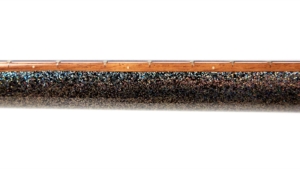 My second complaint with the neck is that the side marker dots are almost completely useless. If the fretboard material was darker then the choice of light colored dots might have made sense, but I think the very light brown would have meant that black dots would have been just as bad. Of course this problem wouldn’t exist if the fretboard was bound with black dots, but I think I’ve made my point on that subject.
My second complaint with the neck is that the side marker dots are almost completely useless. If the fretboard material was darker then the choice of light colored dots might have made sense, but I think the very light brown would have meant that black dots would have been just as bad. Of course this problem wouldn’t exist if the fretboard was bound with black dots, but I think I’ve made my point on that subject.
Build Quality
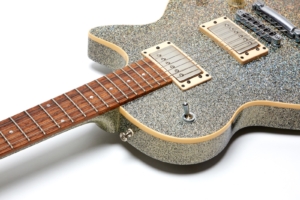 This is a very well made guitar just like every other electric Guild I’ve handled from the Hoboken, Westerly, and Corona plants. This is not a Custom Shop instrument as covered in the Introduction, but that doesn’t make it any less of a great guitar.
This is a very well made guitar just like every other electric Guild I’ve handled from the Hoboken, Westerly, and Corona plants. This is not a Custom Shop instrument as covered in the Introduction, but that doesn’t make it any less of a great guitar.
The guitar body is bound on the front with a simple white or cream-colored binding that I think would look a lot more well balanced if the neck was bound, too.
This guitar weighs 7lbs 14oz (3.57 kg) making it just 2oz shy of eight pounds. Though mostly hollow, the guitar isn’t super-light like a hollowbody Starfire III, but also isn’t a boat anchor like some Les Pauls I’ve played.
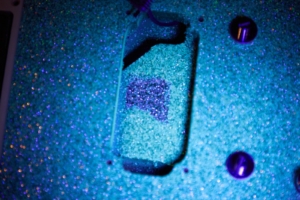 While examining the guitar with a UV light I noticed an odd mark in the bridge pickup cavity. I’m not sure what’s up with that. It almost looks like there’s writing sort of stamped there, but with the finish being what it is it’s pretty much impossible to decipher.
While examining the guitar with a UV light I noticed an odd mark in the bridge pickup cavity. I’m not sure what’s up with that. It almost looks like there’s writing sort of stamped there, but with the finish being what it is it’s pretty much impossible to decipher.
As you’ll see in the next section, the neck pickup route has its own surprise.
Pickups
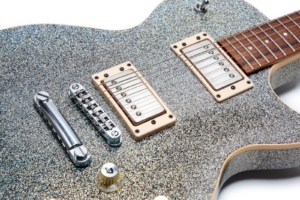 The pickups in this guitar, like other humbucker Bluesbirds of the Fender era, are Seymour Duncan SH1s, with an SH1B in the bridge and an SH1N in the neck.
The pickups in this guitar, like other humbucker Bluesbirds of the Fender era, are Seymour Duncan SH1s, with an SH1B in the bridge and an SH1N in the neck.
The SH1 pickups are also called the 1959s by Seymour Duncan, and the marketing says, The Seymour Duncan SH-1 ’59 Model Electric Guitar Pickup is built with the same kind of enameled wire, nickel-plated studs, and balanced coil windings that humbucker inventor Seth Lover used in his first pickups. It looks and sounds just like a ’59. What they’re trying hard not to say is that it’s supposed to be a Gibson PAF copy.
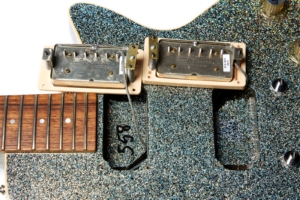 These pickups are a pretty good fit for a Bluesbird because they measure in the ~8.1k Ω in the bridge and ~7.4k Ω in the neck, which isn’t all that far off from the vintage Guild HB1s or, you know, Gibson PAFs.
These pickups are a pretty good fit for a Bluesbird because they measure in the ~8.1k Ω in the bridge and ~7.4k Ω in the neck, which isn’t all that far off from the vintage Guild HB1s or, you know, Gibson PAFs.
By the way, if you have one of these and you can’t read the serial number because of the blinding Holoflake finish, try pulling the neck pickup where you may well be greeted by a nice surprise. I don’t know if this is only on mine, but the last three digits of the serial number are written in what looks like sharpie or more likely black paint.
Electronics
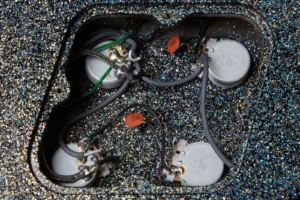 The electronics are pretty much identical to my ’97 Bluesbird with the exception that this guitar has CGE pots made in Mexico which are pretty much the norm on Guilds from the Fender Corona plant era. Like most Guilds after the mid ’70s, the capacitors are nothing more than off-the-shelf ceramic disks, so don’t go looking for that vintage bumblebee tone here. Also, don’t believe the hype about modern versions of vintage bumblebees.
The electronics are pretty much identical to my ’97 Bluesbird with the exception that this guitar has CGE pots made in Mexico which are pretty much the norm on Guilds from the Fender Corona plant era. Like most Guilds after the mid ’70s, the capacitors are nothing more than off-the-shelf ceramic disks, so don’t go looking for that vintage bumblebee tone here. Also, don’t believe the hype about modern versions of vintage bumblebees.
Remember, this is a Fender-era Guild, and Fender is a big company who likes to save money in the name of profits, so the parts are not what I’d call boutique by any stretch though they’re not crap, either.
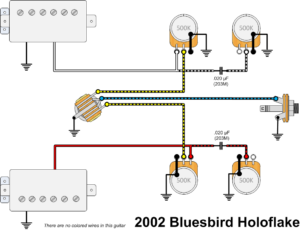 The pots are nice and stiff. I know a fair number of guitarists that prefer loose volume pots for easy volume swells, but as an electronics nerd with years of ham radio experience, loose knobs make me nervous. When I set a pot I expect it to stay where I put it, dammit!
The pots are nice and stiff. I know a fair number of guitarists that prefer loose volume pots for easy volume swells, but as an electronics nerd with years of ham radio experience, loose knobs make me nervous. When I set a pot I expect it to stay where I put it, dammit!
There’s really not much else to say about the electronics other than they’re pretty straightforward and work as they should.
Hardware
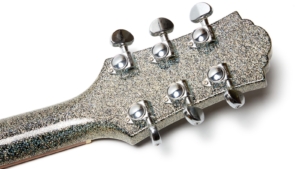 The tuners are Grover Rotomatics, and the hardware on the guitar is the same as all the other Corona-era Bluesbirds out there, including the knobs which are all but impossible to replace if you care about being historically accurate (see why here). If you don’t care about being accurate and just want G-shield clear knobs then you’ll have an easier time finding replacements. As I was putting the final edits on this post, someone posted a small stash of the proper knobs on Ebay so they do show up from time to time.
The tuners are Grover Rotomatics, and the hardware on the guitar is the same as all the other Corona-era Bluesbirds out there, including the knobs which are all but impossible to replace if you care about being historically accurate (see why here). If you don’t care about being accurate and just want G-shield clear knobs then you’ll have an easier time finding replacements. As I was putting the final edits on this post, someone posted a small stash of the proper knobs on Ebay so they do show up from time to time.
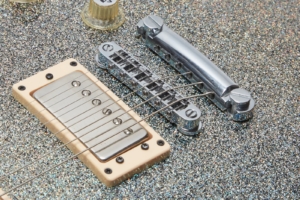 There is no pick guard on this guitar, and there never was one since there are no mounting holes. The strap pegs, bridge, tailpiece, knobs, and pickup rings are all standard Bluesbird parts.
There is no pick guard on this guitar, and there never was one since there are no mounting holes. The strap pegs, bridge, tailpiece, knobs, and pickup rings are all standard Bluesbird parts.
Again, there is nothing special about this guitar aside from the finish and the lack of binding on the fretboard. It’s a Bluesbird like any other non-custom-shop Bluesbird from the Corona plant.
Sound
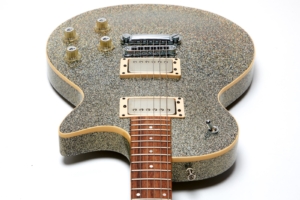 This guitar sounds amazing. The end.
This guitar sounds amazing. The end.
OK, that can’t be the end because I have space to fill in this section, so let’s talk some detail. I keep saying that this is just another Bluesbird, but that’s because it is. From the pickups to the capacitors it’s the same damn guitar as my other Bluesbirds from the same era and if you don’t believe me go buy a bunch and see for yourself. Sure, that’s irrational, but that’s what I did and that’s the conclusion I came to. Still, the guitar sounds amazing and that’s because all these turn of the century Bluesbirds sound amazing. This one just looks cooler.
[dropshadowbox align=”right” effect=”raised” width=”” height=”” background_color=”#ffffff” border_width=”1″ border_color=”#dddddd” ]ODS100 Clean
Open Chords #1
Open Chords #2
D-Shape
7th Chords
JCM-800
A Barre Chords
D-Shape
AC-20
Woman Tone Wankery
[/dropshadowbox]As usual, for these recordings I used my normal Axe-FX III through the QSC K12 speaker recorded direct into my Mac Pro using Audacity. I recorded using the ODS100 Clean patch, as well as the normal JCM-800 barre chord thing that I do.
For each recording I cycle through the neck pickup, both pickups, and finally the bridge pickup. All knobs on the guitar are on 10 at all times.
Well, not always.
The last recording is named Woman Tone Wankery, presented with clams and all, and is played through the AxeFX III’s AC20 (a Morgan AC20 Deluxe) which is a very popular EL-84 equipped 20 watts boutique amplifier that looks like a mini Plexi. It’s based on a Vox, and according to many: far superior. On this recording I’m playing the neck pickup with the tone rolled down which is a rarity for me, but man do I think it sounds good.
I’ve seen people selling these guitars use all sorts of hyperbole, praising them as sounding better than any other Bluesbird or having some sort of magic or mojo, likely due to them being custom shop guitars (which again, they are not). Honestly, I don’t hear it. That’s not to say that the guitar sounds bad. Hell, I think it sounds great! But then I think all Bluesbirds from this era sound great. The pickups can be a bit dark for some, but there’s nothing special about them when compared to a “regular” Bluesbird.
If there’s magic to be had in this guitar, it’s the presence of the finish under bright stage lights, and let’s be honest: we all know that we sound better when we look better.
Playability
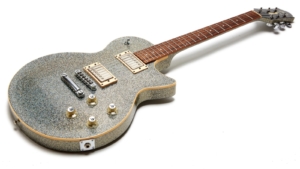 This guitar plays like a Bluesbird, which is to say that it kind of plays like a Les Paul. Kind of.
This guitar plays like a Bluesbird, which is to say that it kind of plays like a Les Paul. Kind of.
As I wrote in the Fretboard and Neck section, the side markers are very difficult to see, but aside from that and being a little bit butt-heavy, it’s plays as you’d expect it to. If you’ve ever played a Corona-era Bluesbird or even a late ’90s Westerly Bluesbird, then you know what this one feels like. If you don’t, then I’m here to tell you that they’re great guitars, and this one has a nice wide well-shaped neck to boot.
Conclusion
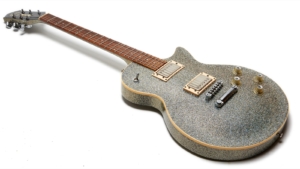 I have owned a pile of Guild Bluesbirds and this one is among the best, but that’s sort of a loaded statement because they’re all fabulous instruments. I also got this one in mint condition while some of my others were well-played so this one seems nicer. Every time I pick up any of them I’m blown away by the playability, looks, and most of all the tone, and this one clearly knocks it out of the park in the looks department.
I have owned a pile of Guild Bluesbirds and this one is among the best, but that’s sort of a loaded statement because they’re all fabulous instruments. I also got this one in mint condition while some of my others were well-played so this one seems nicer. Every time I pick up any of them I’m blown away by the playability, looks, and most of all the tone, and this one clearly knocks it out of the park in the looks department.
I’m a Les Paul guy who currently owns three Custom Shop models (two R9s and an R7), and if financial hardship hit and I had to sell them all I’d have absolutely zero problem keeping a Bluesbird in their stead. Hell I got my ’97 Bluesbird for $800 and it’s a monster!
These Holoflakes sell for a lot of money these days, but I see stories online about people getting them for much less in the not too distant past. Are they worth the premium? From a playability standpoint, no, at least not in my opinion. They’re not custom shop guitars no matter what some Ebay or Reverb ad says, but they were limited and they are fairly rare. Really, they’re just Bluesbirds with a sexy paint job and no binding. Are they great guitars? Yes! But then every Bluesbird I’ve played has been a great guitar. When it comes to tone and playability, this guitar does not outperform my 1997 Bluesbird that I got for almost 1/3 the price.
If I wanted to complain about something I kind of wish it had a bound fretboard like all the other Bluesbirds from this era and the previous years going back to the late-90s. Calling this one a Bluesbird while making it look like a Blues-90 is just weird, but then Guild has never been good at naming things. A bound fretboard would have the added benefit of making the fret markers visible, too. Shine a spotlight on this guitar and no one will even look at the fretboard, though.
Hopefully you saw in my pics and video that these guitars look absolutely amazing. I’ll leave it for you to decide if that incredible finish is worth the money, but I can tell you that every single person I’ve shown it to has been floored by the guitar and I’ve probably been told 20 times to never sell it. Even my wife who couldn’t care less about guitars told me it was pretty.
This is not a shy person’s guitar. This is a guitar that centers the attention on you when you’re playing it. If that’s what you’re after, you can’t go wrong with a Holoflake Bluesbird. Just don’t call it a Custom-Shop NAMM guitar.
Donate: PayPal Crypto:
ETH: 0x0AC57f8e0A49dc06Ed4f7926d169342ec4FCd461
Doge: DFWpLqMr6QF67t4wRzvTtNd8UDwjGTQBGs
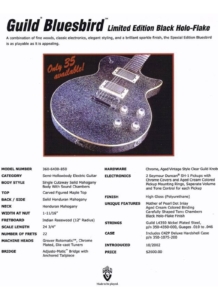
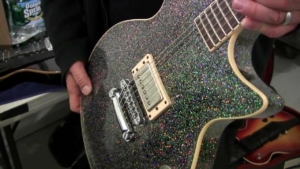
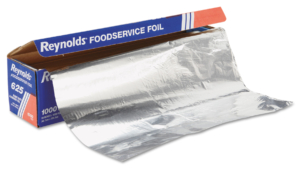
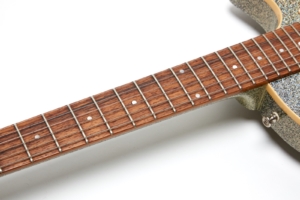

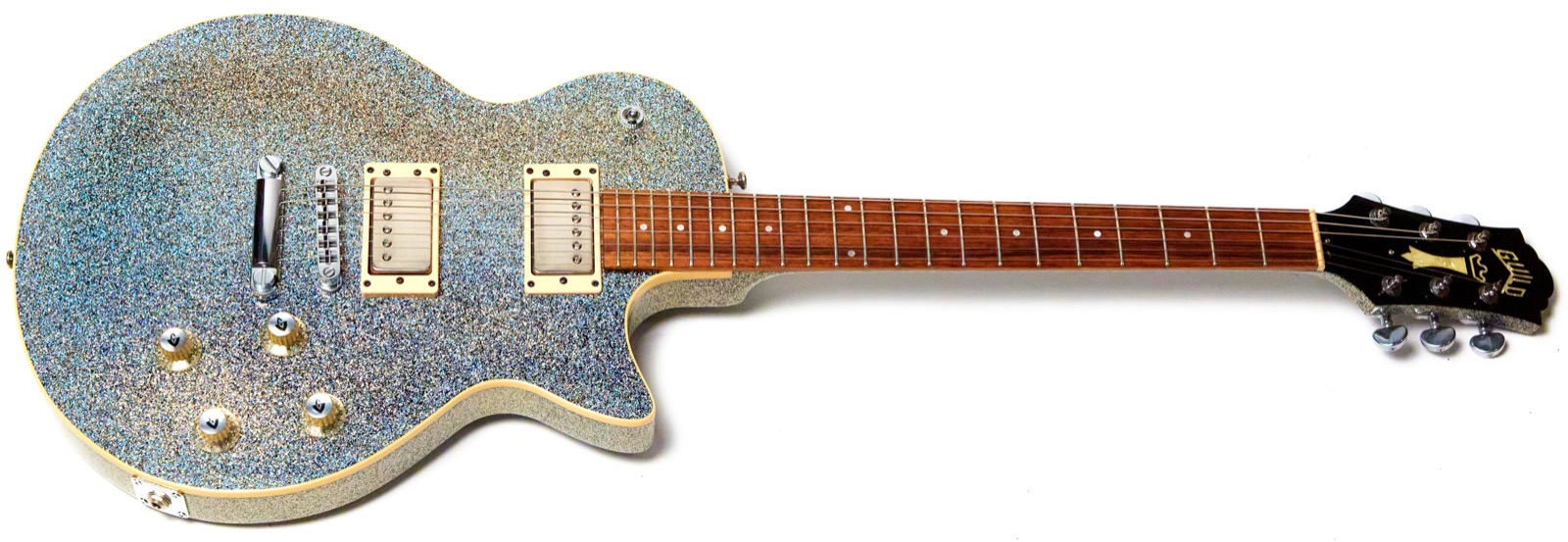

I have one of the guitars that, I believe anyway, was one of the protos for Steve Marker. It’s a single p’up, certified custom shop model (Chris Fleming master build) with natural mahogany back and sides, and the holoflake finish on the front. The block fret markers are also holoflake, and there’s a thin “racing stripe” of holoflake between the rosewood fingerboard and the binding. Unlike the one he plays on stage, this one has a tone knob as well. Haven’t seen much about these in the past couple of years, loved your post, thought I’d share. Hit me up if you want some pics.
Yes please! Email is gad@gad.net.